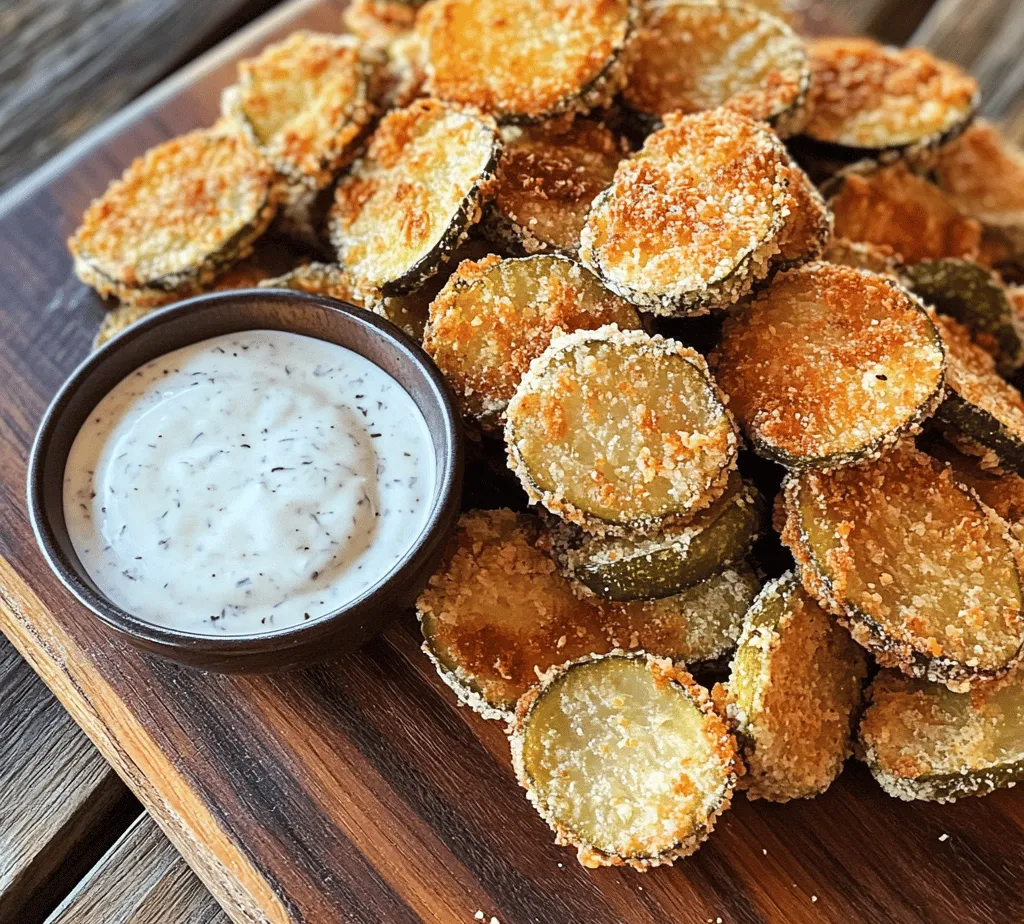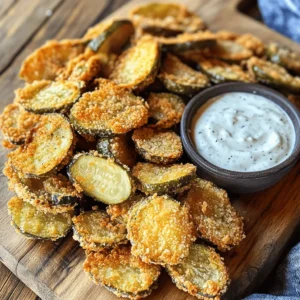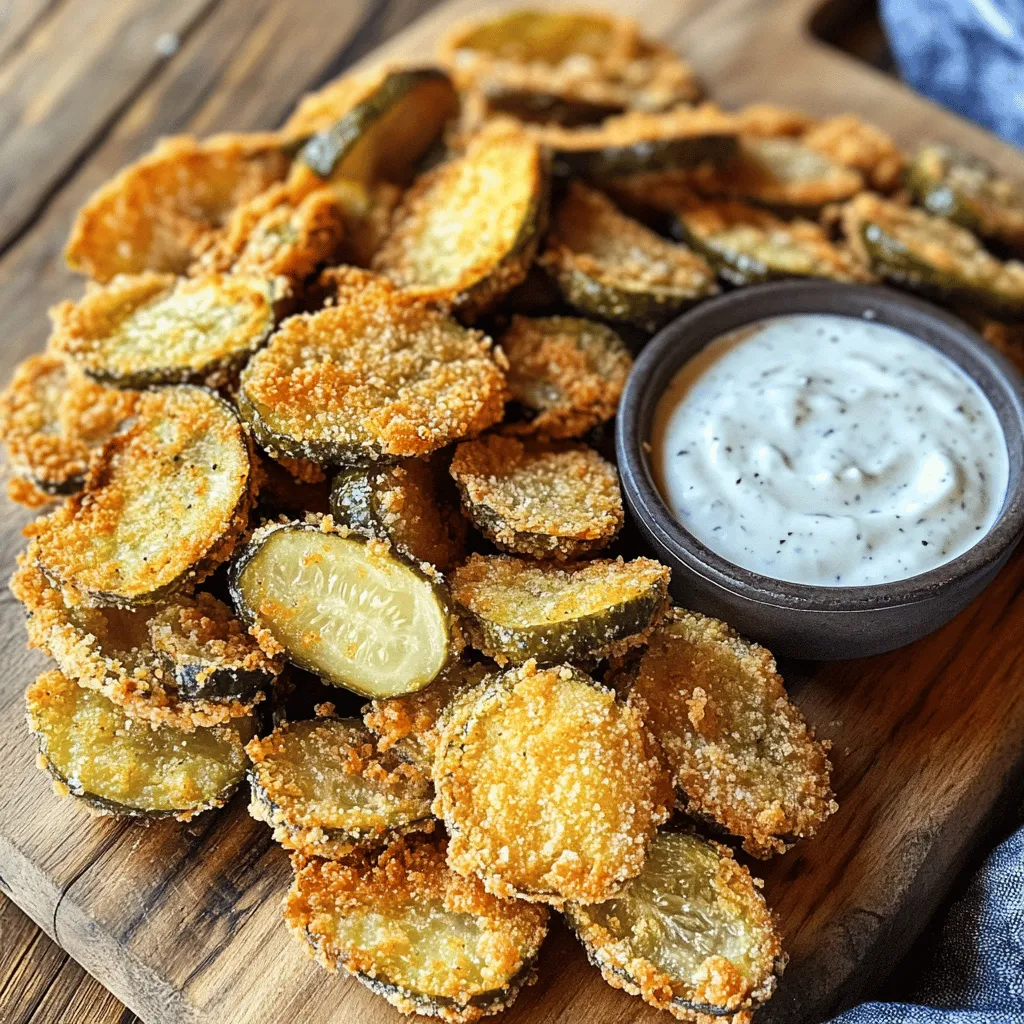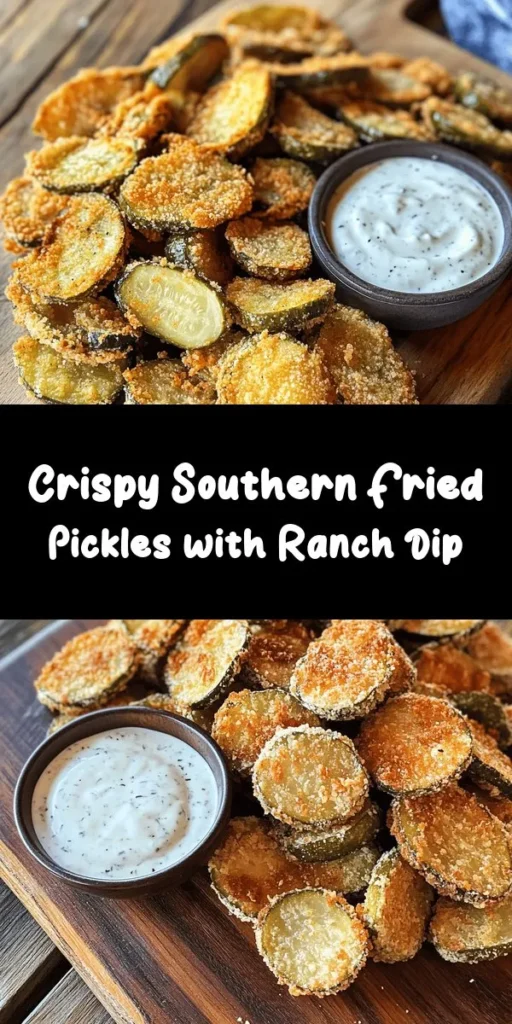Introduction
Southern cuisine is a rich tapestry woven from various cultural influences, showcasing a delightful array of flavors and textures. Among its many beloved snack foods, fried pickles stand out as a quintessential Southern delicacy that has captured the hearts (and appetites) of many. Originating from the Deep South, these crispy, golden-brown treats have become a popular appetizer or snack, gracing menus at bars, restaurants, and family gatherings alike. The allure of fried pickles lies not only in their satisfying crunch but also in their ability to evoke a sense of nostalgia and comfort among those who enjoy them.
In recent years, there has been a growing trend toward unique and flavorful finger foods, with fried pickles leading the charge. As more people discover this mouthwatering treat, variations and creative takes on the classic recipe continue to emerge. Whether enjoyed as a starter alongside a cold drink or served at a backyard barbecue, crispy Southern fried pickles are a must-try for anyone looking to elevate their snacking game.
The Allure of Fried Pickles
Fried pickles hold a special place in Southern food traditions, symbolizing a spirit of hospitality and the joy of sharing good food with friends and family. These crunchy morsels are often made from dill pickle slices that are battered and deep-fried until they become golden and crispy. The combination of tangy pickles and a savory coating creates a flavor profile that is simply irresistible, making them a staple at gatherings and social events.
Across different regions, variations of fried pickles can be found, reflecting local tastes and preferences. Some regions prefer a spicier kick, incorporating ingredients like jalapeños or hot sauce into the batter, while others might experiment with different types of pickles, such as bread-and-butter or spicy pickles. Regardless of the variation, the foundational love for fried pickles remains strong, making them a favorite snack for people of all ages.
The popularity of fried pickles has surged in recent years, earning them a spot on the menu at many bars and restaurants. Their crunchy exterior and tender interior make them a perfect pairing for a variety of dipping sauces, from classic ranch to zesty remoulade. Whether served as an appetizer or enjoyed as a late-night snack, fried pickles are guaranteed to satisfy cravings and spark conversation.
Ingredients Breakdown
Before diving into the cooking process, it’s essential to understand the key ingredients that contribute to the deliciousness of crispy Southern fried pickles.
1. Dill Pickle Chips: The star of the show, dill pickle chips provide the tangy flavor that defines this dish. While some recipes call for whole pickles, using chips ensures the coating adheres well and allows for even frying. Plus, the thin slices create the perfect bite-sized snack.
2. All-Purpose Flour: This common kitchen staple forms the base of the breading. It helps create a crispy exterior when fried and provides structure to the coating.
3. Cornmeal: Adding cornmeal to the flour mixture contributes a delightful crunch and texture to the fried pickles. It enhances the overall flavor, giving a nod to traditional Southern cooking.
4. Spices: A blend of spices, including garlic powder, onion powder, and black pepper, adds depth and complexity to the breading. These spices elevate the pickles from simple to sensational, ensuring each bite is packed with flavor.
5. Buttermilk: The use of buttermilk serves two significant purposes; it adds moisture and enhances the flavor of the pickles. When pickles are soaked in buttermilk before frying, they absorb some of the tanginess, resulting in a more flavorful experience.
6. Oil: For frying, the choice of oil can impact the final product. Peanut oil or vegetable oil are excellent options due to their high smoke points, allowing for even frying without burning.
7. Optional Cayenne Pepper: If you enjoy a bit of heat, consider adding cayenne pepper to the breading mix. This spicy kick enhances the flavor profile and adds an exciting twist to the classic recipe.
Understanding these ingredients and their roles will help you appreciate the art of making crispy Southern fried pickles. Each component contributes to the overall taste and texture, ensuring a delightful snacking experience.
Step-by-Step Guide to Making Crispy Southern Fried Pickles
Now that we’ve explored the allure of fried pickles and broken down the essential ingredients, it’s time to dive into the step-by-step guide for making your own crispy Southern fried pickles. Follow these instructions for a delicious and satisfying treat that’s sure to impress!
Prep the Pickles
The first step in making crispy fried pickles is to prepare the pickles themselves. Proper preparation is key to achieving that coveted crunch.
1. Slice the Pickles: If you’re using whole dill pickles, start by slicing them into 1/4-inch thick chips. Uniform thickness is essential for even frying, so take your time to ensure consistent sizes.
2. Drain and Dry: After slicing, it’s crucial to drain the pickle chips thoroughly and remove any excess moisture. Use a paper towel to pat them dry gently. This step is critical, as excess moisture can lead to a soggy coating and prevent the pickles from crisping up during frying.
3. Let Them Rest: Once dried, place the pickle chips in a single layer on a baking sheet lined with paper towels. Allow them to sit for about 10-15 minutes to ensure they are as dry as possible before breading.
Make the Breading
With the pickles prepped, it’s time to create the flavorful breading that will give your fried pickles their signature crunch.
1. Combine Dry Ingredients: In a mixing bowl, combine all-purpose flour, cornmeal, and your chosen spices (garlic powder, onion powder, black pepper, and salt). Whisk them together until well blended. This mixture will form the dry coating for your pickles.
2. Taste Testing: Before using the breading, it’s a good idea to taste it. Adjust the seasoning as necessary, adding more salt or spices to suit your preferences. This step is vital to ensure your fried pickles are bursting with flavor.
Prepare the Coating Station
An organized cooking space is essential for a smooth frying process. Here’s how to set up your coating station for efficiency.
1. Set Up Three Bowls: Arrange three shallow bowls in a row. The first bowl will contain the buttermilk, the second will hold the dry breading mixture, and the third will be for the fried pickles once coated.
2. Dip and Coat: Take a sliced pickle chip and dip it into the buttermilk, ensuring it’s fully coated. Then, transfer the pickle to the bowl with the breading mixture, pressing gently to adhere the coating. Make sure the chip is fully covered and shake off any excess breading.
3. Repeat the Process: Continue this process with the remaining pickle chips, ensuring they are well coated before placing them in the third bowl or on another plate.
Now, you’re officially ready to move on to the frying stage, where the magic happens, and your crispy Southern fried pickles come to life!

Coat the Pickles
Coating your pickles is a crucial step in achieving that perfect crispy texture. The right coating ensures that the batter adheres well, delivering a satisfying crunch with every bite. Here’s how to properly coat your pickles for the ultimate Southern fried experience.
Step-by-Step Guide to Properly Coat the Pickles
1. Prepare Your Coating Stations: Set up two distinct stations—one for the dry ingredients and one for the wet ingredients. The dry station will include the seasoned flour mixture, while the wet station will consist of the buttermilk or egg wash.
2. Start with the Dry Coating: Take a pickle slice and dip it into the seasoned flour mixture, ensuring it’s fully covered. Shake off any excess flour to avoid clumping.
3. Wet the Pickle: Next, dip the floured pickle slice into the buttermilk or egg wash. Make sure the flour is moistened but do not soak it. This step is essential as it helps the final layer of flour adhere properly.
4. Return to Dry Coating: Finally, return the pickle slice to the seasoned flour mixture for a second coat. This additional layer is key to achieving extra crunch. Press lightly on the slice to ensure an even coat without damaging the pickle.
5. Repeat: Continue this process for all your pickle slices. Remember that lightly pressing during the coating process is vital for an even coating that will fry beautifully.
Heat the Oil
Once your pickles are coated, it’s time to heat the oil. Proper oil temperature is crucial for achieving that golden brown finish and crispy texture.
Best Practices for Heating Oil and Frying Safely
– Choose the Right Oil: Use oils with high smoke points like vegetable oil, canola oil, or peanut oil. These oils can withstand high temperatures without burning.
– Heat Gradually: Pour enough oil into your frying pan (or deep fryer) to submerge the pickles. Heat the oil over medium to medium-high heat. It’s essential to heat the oil gradually to avoid uneven cooking.
– Check the Temperature: The ideal frying temperature for crispy fried pickles is between 350°F to 375°F. You can use a cooking thermometer to monitor the oil temperature. If you don’t have a thermometer, drop a small amount of batter into the oil; if it sizzles and rises to the surface, the oil is ready.
Explanation of Oil Temperature and Its Effect on the Frying Process
Maintaining the right oil temperature is critical during frying. Oil that is too hot can burn the coating before the pickles are cooked, while oil that is too cool will lead to a soggy texture as the pickles absorb too much oil. A well-regulated temperature ensures that the pickles cook evenly, resulting in a crisp exterior and a tender interior.
Fry the Pickles
Now that your oil is heated, it’s time to fry the pickles.
Detailed Instructions on Frying Times and Techniques
1. Carefully Lower the Pickles: Using tongs or a slotted spoon, gently lower the coated pickle slices into the hot oil. Avoid dropping them in as this can cause oil splattering.
2. Fry in Batches: It’s crucial not to overcrowd the pan. Fry in small batches to maintain oil temperature and ensure even cooking. Typically, frying 4-6 pickle slices at a time works well.
3. Cooking Time: Fry the pickles for about 3-4 minutes or until they turn golden brown. Flip them halfway through the cooking time for even browning.
4. Monitor the Oil Temperature: If the oil temperature drops too low, adjust the heat to bring it back up. This might require some attention as you fry multiple batches.
Drain Excess Oil
Once fried to perfection, it’s important to drain excess oil from the pickles properly.
Importance of Draining Fried Foods Properly
Draining excess oil not only helps in achieving a healthier dish but also enhances the overall crunch by preventing sogginess.
Best Practices for Using Paper Towels to Absorb Excess Oil
– Use a Paper Towel-Lined Plate: Place a large plate or baking sheet lined with paper towels nearby. Once the pickles are golden brown, use a slotted spoon to transfer them onto the paper towels.
– Allow to Cool: Let the fried pickles rest for a minute on the paper towels to absorb any remaining oil. This step is essential for maintaining their crispy texture.
Serve
Now that your crispy Southern fried pickles are ready, it’s time to make them shine on the plate.
Suggestions for Presentation and Serving
– Arrange Neatly: Place the fried pickles on a serving platter in a single layer to showcase their golden color. You can garnish with fresh herbs like parsley or dill for an appealing presentation.
– Classic Dipping Option: One of the best ways to enjoy fried pickles is with ranch dressing. The creamy, tangy flavor of ranch complements the crunch of the pickles perfectly. You can also provide a variety of dips such as spicy mayo, blue cheese, or even a homemade aioli for added flavor.
Common Mistakes to Avoid
Frying pickles might seem simple, but there are common pitfalls that can hinder your results.
Frequent Pitfalls When Making Fried Pickles
1. Inadequate Coating: Ensure you follow the coating process carefully. Skipping the double coating can result in a less crispy texture.
2. Overcrowding the Pan: This is a major mistake that leads to uneven cooking. Always fry in small batches to maintain oil temperature.
3. Incorrect Oil Temperature: When the oil is too hot, the coating burns; if too cool, the pickles become greasy. Always use a thermometer or a test slice to ensure the right temperature.
4. Not Draining Properly: Leaving fried pickles on a plate without draining can cause them to become soggy. Always use paper towels to absorb excess oil.
Tips for Ensuring Optimal Crunch and Flavor
– Use Fresh Pickles: Fresh, crisp pickles yield the best results. Avoid using overly soft or old pickles.
– Season Generously: Don’t be shy with the seasoning in your flour mixture. The flavor of the crust is equally important as the pickle inside.
Pairing Suggestions
Fried pickles are versatile and can be enjoyed in various ways. Here are some pairing suggestions that elevate your Southern snack experience.
Ideas for Beverages and Dishes That Complement Fried Pickles
– Beverages: Serve your fried pickles with a cold beer, lemonade, or sweet tea for a refreshing balance. A light lager or a pale ale pairs excellently with the crunch and flavor of the pickles.
– Dishes: Incorporate fried pickles into a larger meal setting. They make a great appetizer alongside burgers, sandwiches, or barbecue dishes. You can also serve them during parties as part of a snack platter with other finger foods.
Conclusion
Homemade crispy Southern fried pickles are a delightful treat that combines simplicity with mouthwatering flavor. The process may seem daunting at first, but with careful attention to detail—from coating to frying—anyone can achieve this Southern classic at home.
Experiment with variations, such as adding spices to the batter or trying different dipping sauces. Share your creation with friends or family to spread the joy of cooking and enjoying comfort foods. Fried pickles are not just a snack; they represent the heart of Southern cuisine—warm, inviting, and full of flavor. So gather your ingredients, follow these steps, and prepare to enjoy a crunchy, tangy delight that will leave everyone asking for more.



